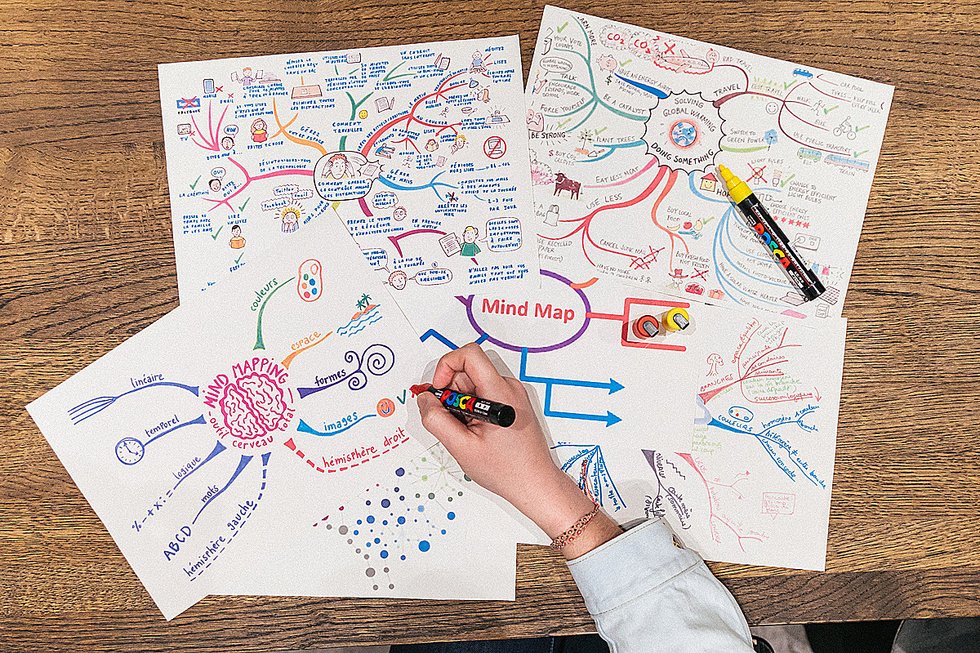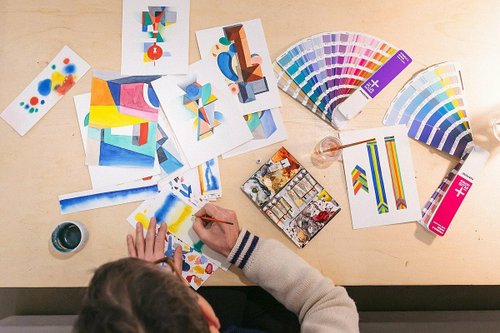Mind mapping: organise your ideas creatively and efficiently
Jan 06, 2020
4 mins

AD
Fondateur, auteur, rédacteur @Word Shaper
Our minds are busy, always in demand and sometimes even tormented. Ideas bounce around in the vortex of our frazzled brains. They connect in ways that we barely understand and get so tangled up that it can sometimes make it hard to think straight. Mind mapping is about representing your train of thought in a clear, constructed way by putting it down on paper in the form of a tree. Mind mapping lets you fully explore and exploit all of your thoughts, instead of becoming overwhelmed by the constant flow of ideas. Here, we tell you everything you need to know about this handy tool, which is useful both personally and professionally.
The history of mind mapping
The British psychologist Tony Buzan spent decades of his life researching brain function, learning and memory. He came up with mind mapping in the 1970s. At the time, he hosted the BBC TV series Use Your Head on which he taught his “mind map” concept. His idea was based on the fact that the right side of our brains is better suited to visual stimulation and synthesis than the left side. He believed that teaching methods should take this more fully into account in learning and memory processes. Buzan conceived the mind map as a way of reconciling the right side—the more creative side—with the left side, which is more logical and analytical. This principle takes the shape of a diagram that allows for the visual representation of links between several concepts.
This mental map makes it possible to bring together ideas that are otherwise considered disconnected by using colours, diagrams, lines and any other element that helps it make sense. It is organised around a central theme. A network of branches is then added to bring up ideas through keywords or drawings. Each main branch or idea can lead to secondary ideas which then multiply, a bit like a family tree. As Buzan explained, the mind map “radiates” because it follows our natural train of thought.
How do you use mind mapping?
Mental maps are visual representations that make it easier to resolve problems and optimise situations. They encourage concentration, memory function and problem-solving. This makes them effective for project management, whether you’re working alone or in a team. In fact, these maps can be created collaboratively too. It’s a tool that can help you prepare for public speaking, a brainstorming session, or for personal or professional discussions. You can also use them to share a project’s progress with a client, especially if you work freelance or in a creative industry such as graphic design, advertising or architecture. Quentin, an advertising creative, says, “I often work on long-term projects and despite the deadlines, which are announced well in advance, clients inevitably get impatient. I share mind maps with them to let them see the team’s progress on the project. It reassures them, they get a better overall view, and they appreciate the link between the creative team and client.”
Mind maps can also save the day when it comes to taking notes and retaining information. They are often used by students, but they are just as useful in a meeting or during a conference to connect the dots between ideas that aren’t inherently linked. Leslie, a general medicine intern, says, “I failed my first year of medical school. I worked really hard and crammed for the exams, but it felt like my mind was playing tricks on me. My mind was all over the place. A friend told me about mind mapping and I tried to use it in class. I was able to structure everything in my own way, to connect concepts and memorise everything much more efficiently. Even now, in my sixth year, I have notebooks full of mental maps all over my house and in my bags. It’s a powerful tool that really does follow the natural way the brain works. It lets you get organised, take a step back and find the solutions you wouldn’t have otherwise seen.”
“It’s a powerful tool that lets you get organised, take a step back and find the solutions you wouldn’t have seen otherwise.” - Leslie, medical student
How do you go about it?
- First, take the time to determine what the central idea is. Are you looking for a solution to a project? A new career path? An internship?
- Get the necessary materials and make sure you have enough space to let your ideas run wild. For example, if you’re using paper, use at least one sheet of A3 turned horizontally.
- Draw the branches that correspond to each idea and make sure you choose a different colour for each one.
- Ask yourself the right questions so that you go through everything you want to address: your skills, your options, organisations to contact, your role models or anyone else related to your initial theme.
- Go on to detail the secondary ideas, which shoot out from each main branch.
- Illustrate your mental map with diagrams, drawings and symbols to make it more dynamic. Stimulating all the senses encourages both information retention and new ideas to develop.
The best tools and software for mind mapping
A piece of paper, some pens and coloured markers may do the trick, but mind-mapping software also offers several options for harnessing your ideas. All the tools mentioned below are free and will help you to create a mind map.
- Wisemapping: This online program lets you create your map and then export it to a blog or wherever else you choose.
- MindMeister: An easy-to-learn tool. You can easily personalise the template map provided.
- Coggle: This collaborative tool is ideal for project management or team projects. You can collectively create a map and follow its growth while it tracks and notes all the changes.
- MindMap: A Chrome extension that synchronises with Google Drive. Add all sorts of files to your mind map and organise them, all from your browser.
- LucidChart: An end-to-end tool that offers many possibilities to organise your ideas and manage projects. There is a collaborative mode available, as well as instant messaging and a comment section.
Buzan, who passed away in April 2019, left behind a rich legacy. His mind-mapping tool is becoming increasingly popular and its merit is clear. Mind mapping can be adapted to all situations, both personal and collaborative, and it allows you to evaluate everything, sparks your creativity and uses your mind to its full capacity. So are you ready to get the left and right sides of your brain working together?
Photo: WTTJ
Translated by Kalin Linsberg
Follow Welcome to the Jungle on Facebook and subscribe to our newsletter to receive our best articles.

More inspiration: Creativity

5 books to boost your creativity at work
Creativity at work is important, but sometimes we aren't inspired by our daily lives. We've curated a list of books to kickstart your creative mind!
Oct 04, 2023

How creativity became corporate religion
By idolizing the image of the feverishly driven artist, capitalism created new ways to exploit workers
Sep 05, 2023

Learn to boost your creativity (and let go of your fears)
No one is immune to the effects that negative feedback can have on their creativity. Danielle Krysa, the author of Your Inner Critic is a Big Jerk...
Feb 21, 2022

Take a walk to boost your health and creativity
The simple act of taking a walk improves our general wellbeing, focuses our attention and boosts our creativity.
Apr 14, 2021

Costume drama: exploring the creative process with designer Lorna Mugan
She’s been nominated for a Bafta and an Emmy, but it’s unlikely you’ll recognise her face. Meet Lorna Mugan, a costume designer from Donegal.
Oct 12, 2020
The newsletter that does the job
Want to keep up with the latest articles? Twice a week you can receive stories, jobs, and tips in your inbox.

Looking for your next job?
Over 200,000 people have found a job with Welcome to the Jungle.
Explore jobs